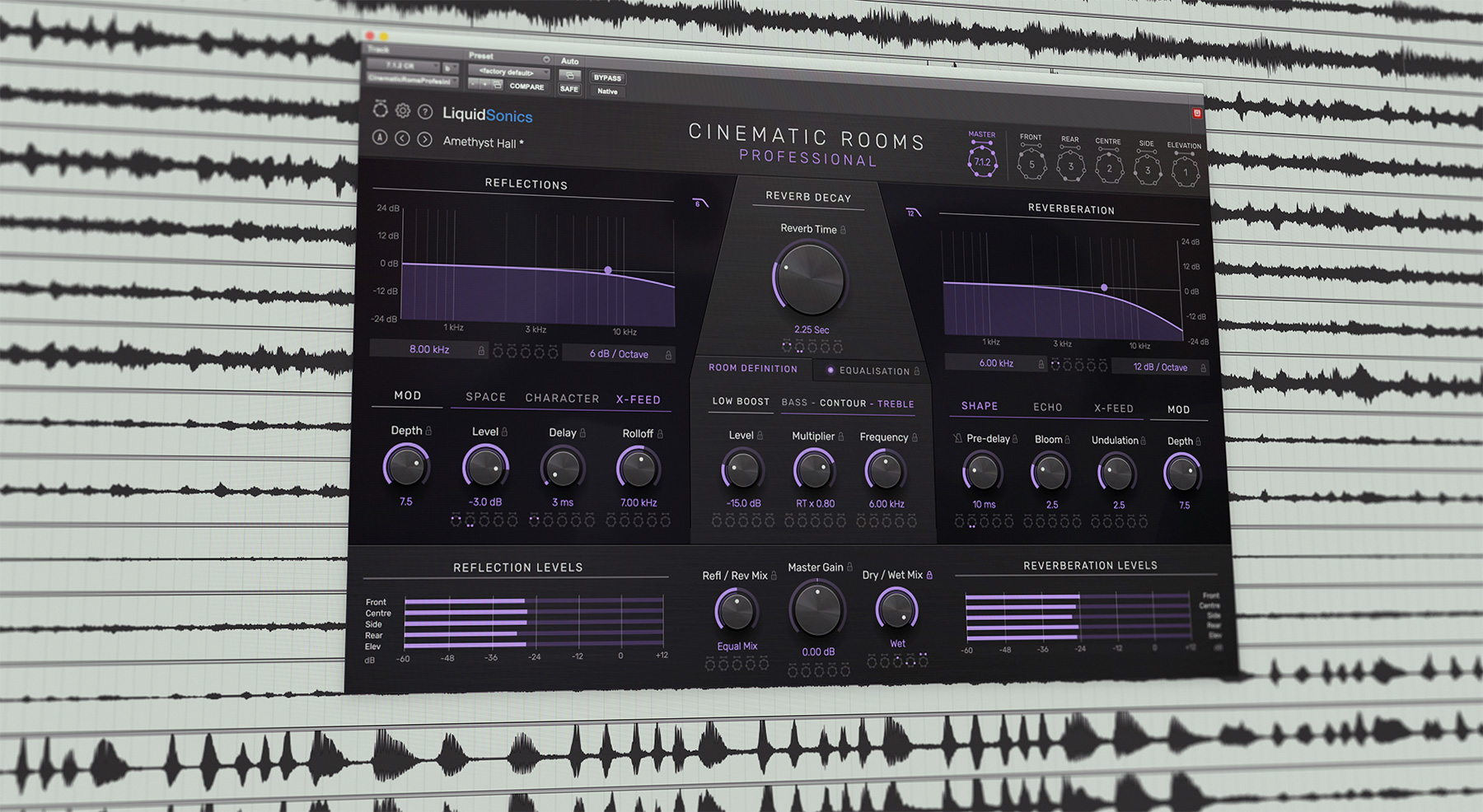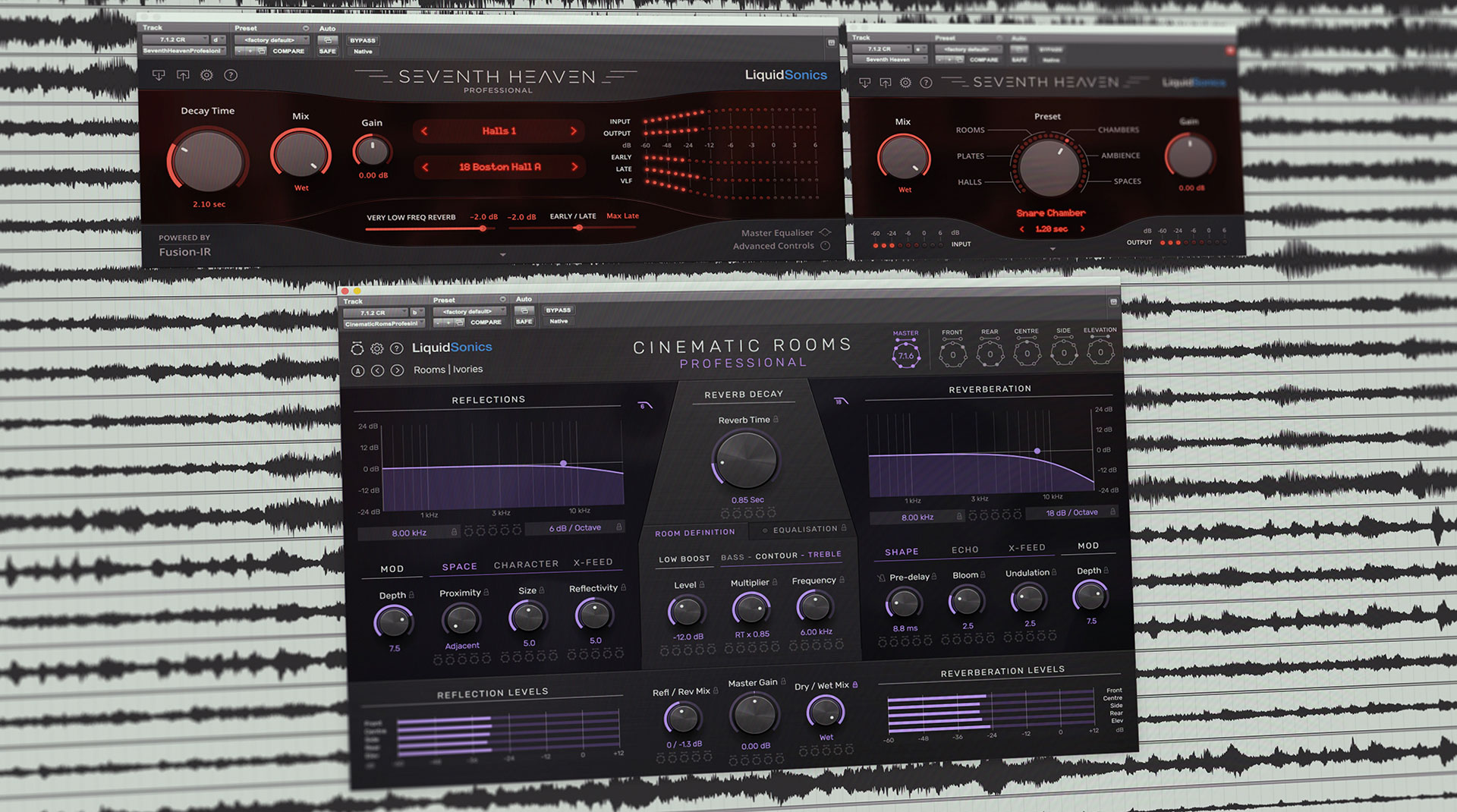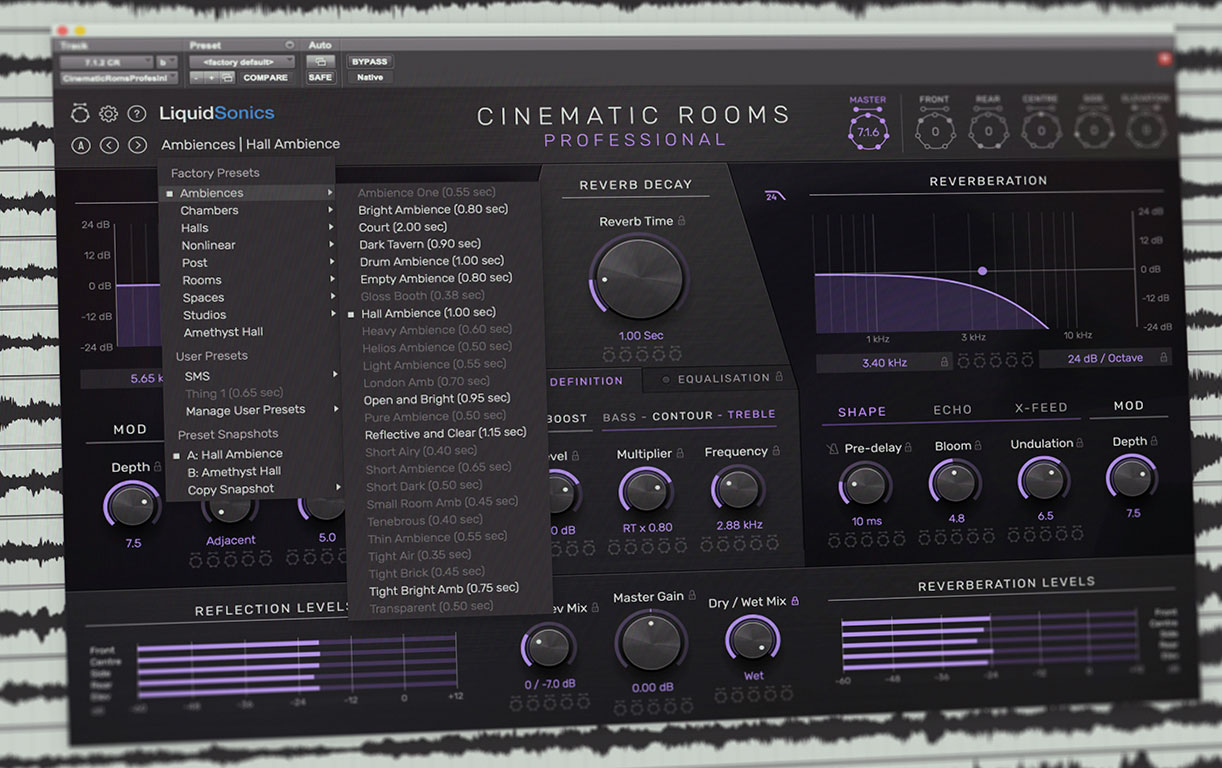
The last decade was transformative for native reverb. We software developers went from being laughed out of the room at the suggestion a native reverb could compete with even mid-range hardware. Now many people seriously ask themselves whether they need to invest in 19-inch rack units at all.
We are blessed with an embarrassment of riches in the field of stereo reverb in 2020. If you have ever had to buy a present for a wealthy relative, you know the pain of finding something new and exciting for them when they may feel they have everything they could possibly need or want already. Reverb designers feel it too!
We know we have to dig deeper and deeper to entice you and convince you that we have something worthy of your attention. It certainly motivates the imagination!
In late 2018 when Cinematic Rooms was just a fleeting moment of inspiration, it was clear that this time I had to think bigger. My marketing wizard is no stranger to Exponential growth so was able to link me up with some of the world’s best composers, score mixers and post-production engineers. With their help and support, I have been able to design a tool that could meet their increasingly demanding workflow, acoustic and sound quality requirements. I have been humbled by their responses, but this particular precision-guided weapon was locked on to those targets…
So why is Cinematic Rooms getting so much great feedback from producers sitting in front of stereo monitors? Many of the headline features such as surround editing planes and channel count support for up to 7.1.6 so clearly focus on surround workflows.
While many professionals working at the highest level of score mixing and post production are emphatic about its exceptional sound quality, some working in stereo are understandably writing in to ask me why they could ever need another reverb when they have so many great ones already. Hence, I need to write about why some of Cinematic Room’s fantastic features are sounding so good in studios set up for stereo work.
So here is a collection of my own thoughts and some of those of shared with me by others about why Cinematic Rooms Professional will compliment the many incredible stereo reverbs already in your plug-ins drawer!
1. Cross-feed definition for superior imaging control
Some very early stereo reverbs would mix down stereo channels to mono, then create a stereo image from this mono source. That helped to reduce DSP requirements and kept hardware costs to a minimum when A/D conversion was far more expensive than it is today. Many advancements later and we have arrived at the true stereo reverb processing we now expect.
A true stereo reverb has a clearly audible path from the left channel into the right, and vice versa. All of this reverb should mathematically have a low degree of similarity (correlation) to avoid phase problems. There is usually a little extra pre-delay (around 10ms) and attenuation (around 6dB) on a crossfed path. This means reverb bleeds naturally between the channels, creating a cohesive space while retaining a good stereo image without causing psychoacoustic problems due to the precedence effect.
Not many reverbs give you any control over their cross-feed properties, because they can’t. That is because they typically inject all the input channels into one or more shared circular delay lines at junctions around the loop, and read out of the loop in different places to feed the different channels. That means the channel of origin of an acoustic contribution for any given output is not known, so they can’t make intelligent decisions about how a channels’ contribution could be routed to a given output channel.
Think of the individual channels as coloured ink going into a blender. They go in, get mixed up at high speed, and it all comes out brown.
This means a loss of control over pan tracking and imaging. If you pan a source left, and then send it to a true stereo reverb aux, the reverb will spill into the other channel by a predefined amount at a predefined time, sounding basically the same. Usually that’s OK, but sometimes it’s quite limiting and you can do nothing about it.
With Cinematic Rooms Professional you can control the amount of crossfeed in the reflections and the reverb independently. That means you could keep your early reflection image very tight (low crossfeed) while allowing the late reverb to spill out across the sound-field (high crossfeed). Or you could keep them both tight to the source channel and ensure they track an instrument as it pans. This is especially powerful in surround, but helpful in stereo as well.
In very large spaces it means you can create powerful psychoacoustic effects where the crossfeed almost turns into a slap delay simulating a huge space. Using the rolloff you can even simulate the effect of high frequency loss as sounds travels through the air.
In small rooms it means you can enhance the sense of claustrophobia by pulling back on ear’s perception of space that arises from the delayed crossfeeding of signals between channels.

2. Achromatic reflections creating clean, tight spaces
The reflections in Cinematic Rooms are very special, and in the professional edition you have a level of control unlike any other reverb in its class. I spoke about the benefits of the reflection technology in my last post, and it is great to know so many people are loving how they sound.
“This verb is amazing. I do most of my work in the Techno world so I like to experiment with creating new and interesting textures in unconventional ways. The ER reflection has no artefacts when you change the setting so I routed an LFO to it and put it on a polymetric FM techno synth sequence… and it created this AMAZING unpredictable texture that the average listener probably won’t even notice but definitely feel. Made the static line just come to life. I LOVE this verb.”
[GearSlutz Forum, comment posted by seanandroid]
In the professional edition you can create some wonderful small spaces. This is because when the decorrelated reflections are placed close to each other they exhibit none of the comb filtering artefacts you commonly hear in other reverbs with tight delay lines. It is unique, and works brilliantly in stereo as well as surround.
3. A dash of secret sauce – Cinematic Rooms’ algorithmic colour palette
Contemporary reverbs set out to create a hyper dense and spectrally pure reverb, and of course they sound very realistic but that can sometimes be a little too clean (some may say clinical). They often can’t express the fundamental variability between presets that you would expect when flicking through the chambers or small rooms in a sampled product like Altiverb.
The Cinematic Rooms algorithm has a very clean and contemporary sound at its foundation, but has a lot of secret technology under the hood to gently shape the acoustic profile of the environments it generates to more accurately portray the kind of reverb we are simulating.
The initial reflective and late reverberant acoustic profiles of hundreds of real spaces were analysed, profiled and categorised – this data is fed into the algorithm at key points which allows Cinematic Rooms to produce room acoustics that are extremely realistic whilst retaining the smooth and clean contemporary sound that people expect from modern reverb devices.
Credit where it’s due – the technology here was invented after we had some discussions with Marti Humphrey at The Dub Stage about his requirements of tight spaces for use in post. Cinematic Rooms really wouldn’t have been the same without him!

Some people have been asking specifically why they might be interested in Cinematic Rooms if they already own Seventh Heaven, Lustrous Plates, Illusion or any other of their favourites. The answer is clear for those working in surround, but for some working in stereo it isn’t so obvious. I am pleased to say however that many very satisfied Seventh Heaven owners are finding Cinematic Rooms to be a wonderful companion due to its increased levels of flexibility.
4. Reflection diffusion and spacing control
Cinematic Rooms’ reflections can be shaped without impacting their achromaticity. This means you can make them more specular (sharp / snappy) as you would experience in a very reflective environment such as a tiled room, or more diffuse (softer) as you find in softer spaces like living rooms without compromising their purity. More diffuse reflections gently smooth transients, and more specular reflections enhance clarity.
The reflections in Cinematic Rooms are so well decorrelated there is no reason to keep them apart, so we can bring them closer together and push them farther apart. They can even sit atop one another so in Cinematic Rooms you can create very small spaces that sound spectrally clean and acoustically very tight with the diffusive properties a particular environment demands.
5. Width control
Often a producer would like to narrow down the width of a wide reverb; many reverbs will provide such a facility and Cinematic Rooms is no exception – right down to mono.
Although by default LiquidSonics reverbs are very wide, sometimes a producer needs to accentuate the width using mid/side techniques – Cinematic Rooms Professional allows you to dial in +150% of mid/side boost to create a huge sense of width.
As an aside, I thought by default the reverb was wide enough – but I’m sure there’s no shame in admitting the infallible ear of Alan Meyerson convinced me that we could go further!
6. Greater variety of roll-off curves
Seventh Heaven’s filter shapes are determined by the reverb engine and algorithm mode. Reflections have a shallow roll-off, a v1 preset has a very fast late roll-off and a v2 a shallower late roll-off. Although you often would not have any desire to change those, some users have written in asking to do just that but I have always resisted this from a desire to stay as true to the hardware as possible.
The ability to change filter rolloff curves is not unique to Cinematic Rooms of course, but the rolloff shapes in Cinematic Rooms were tuned by ear for many weeks to provide a satisfyingly musical response.
7. Echo rolloff
The delay unit on the M7 is a multi-voiced modulated beast that sometimes does not gets the attention it deserves! I was at a time tempted to add an extra roll-off filter on the delay for Seventh Heaven but did not do so on authenticity grounds – but now felt like the right time to revisit the idea for Cinematic Rooms Professional’s echoes unit.
A late slap-back in the reverb tail would usually have been subject to additional filtering as it travels through the air or reflects off surfaces, so this is a very useful property to be able to control.

8. Control over modulation
The M7 has wonderful modulation of its early reflections, low frequency reverb and tail (in v2 presets) that are key to its signature sound. This is reproduced as accurately as possible within Seventh Heaven using three bespoke modulated Fusion-IR convolution reverb engines that all work at different modulation rates – but just like the hardware, you cannot change or remove that modulation.
Again, people have written in asking me to change this, but I prefer to avoid deviating too far from the original design choices taken by Bricasti. In Cinematic Rooms I felt it was appropriate to include such a feature – but if you want a less dynamic sound in Seventh Heaven stick to the v1 presets as the v2 is where you find the really wild rides!
9. Reverb time preset filtering
At present the only reverb in the LiquidSonics range to feature preset filtering based on reverb time is Cinematic Rooms. That’s another gem of an idea from Mr. Meyerson! This may percolate through to other reverbs in the range over time, but as of today it is a neat workflow bonus that you will only find in Cinematic Rooms.

10. To infinity…
While I have been extolling the virtues of modulated convolution synthesis and capture playback for years, I had to concede that the memory and processing demands of a long multi-channel modulated convolution reverb simply do not scale well to 7.1.6.
Algorithmic reverbs are better suited to this requirement by design, but I rarely find they satisfy my personal preference when it comes to density and spectral purity (although there are a handful of notable exceptions that I admire greatly). I needed to find another way to achieve the extremely high densities and purity of tone that I demand from reverb without introducing any of the metallic/ringing/chorusing qualities which I am not fond of. The Cinematic Rooms algorithm does not use samples or Fusion-IR as in many other LiquidSonics reverbs, but I am pleased to say that using a novel algorithm I have achieved the goal I set for myself.
Those with slow internet links or small SSDs in laptops can breathe a sign of relief that I’m not going to be asking for another couple of gigabytes of space! It also means reverb updates are faster and for the first time in a LiquidSonics reverb we have infinite tail lengths which can create some wonderfully complex evolving textures for use in ambient sound design work. I’m confident that you’ve never heard an infinite reverb tail this dense and pure, it is a real step forwards.
For those that got to the end of another epic blog post, I hope you found this deep dive useful. Until next time… thanks, and I hope you enjoy Cinematic Rooms however many monitors you have in your studio!
Matt
